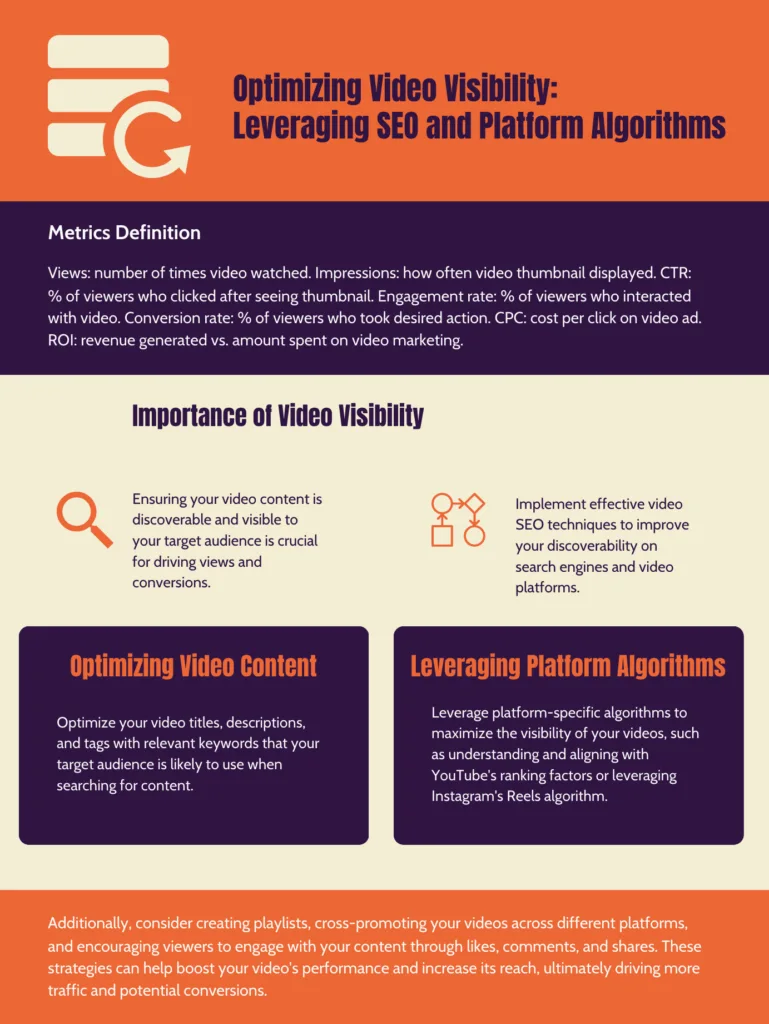Why should you track video marketing performance?
Video marketing stands as a critical component of an effective marketing strategy, offering a dynamic and engaging way to connect with audiences.
Tracking video marketing performance is essential because it provides valuable insights into the effectiveness of your content, helping you understand what resonates with your audience. By analyzing metrics such as view count, engagement rates, and conversion statistics, businesses can gauge the return on investment (ROI) of their video campaigns and identify areas for improvement.
Moreover, tracking performance allows marketers to refine their strategies, optimize content, and better allocate resources to maximize impact. It also enables businesses to stay competitive in a rapidly evolving digital landscape by adapting to viewer preferences and trends.
Ultimately, by systematically measuring the success of video marketing efforts, companies can enhance audience engagement, boost brand awareness, and drive growth.
This blog post will explore eight methods to effectively track and leverage video marketing performance to achieve these goals.
Key Takeaways
- Video marketing is a powerful tool for businesses to engage with their audience and drive conversions.
- Identifying your target demographic is crucial for creating effective video content.
- Captivating content strategies include storytelling, humor, and emotional appeal.
- Optimizing video visibility through SEO and platform algorithms can increase reach and engagement.
- Measuring key metrics such as views, engagement, and conversions is essential for video performance tracking.
The Power of Track Video Marketing Performance
The rise of video platforms like YouTube, Instagram, and TikTok has transformed the way consumers engage with and consume content, making video marketing a crucial component of any successful marketing strategy.
The impact of video marketing on brand awareness and customer engagement is undeniable.
Studies have shown that video content can increase brand recall, improve information retention, and foster deeper emotional connections with viewers.
Moreover, the interactive and immersive nature of video has the potential to drive higher engagement rates, leading to increased website traffic, lead generation, and ultimately, conversions.
Given the significance of video marketing, it is essential for businesses to optimize their video marketing strategy to maximize its effectiveness. By understanding your target audience, creating captivating content, leveraging SEO and platform algorithms, and measuring key metrics, you can unlock the full potential of video marketing and propel your brand toward greater success.
Understanding Your Audience: Identifying Your Target Demographic

To effectively track video marketing performance begin with a deep understanding of your target audience.
Conducting thorough market research is crucial to uncover the preferences, behaviors, and pain points of your ideal customers.
Analyze demographic data such as age, gender, location, and income level, as well as psychographic information like interests, values, and lifestyle choices.
Armed with this data, you can tailor your video content to resonate with your target audience more effectively.
Consider the types of videos they are most likely to engage with, the platforms they frequent, and the tone and messaging that will capture their attention. By aligning your video content with the specific needs and preferences of your target demographic, you can create a stronger connection with your audience and increase the likelihood of driving desired actions, such as website visits, lead generation, or sales.
Furthermore, regularly monitoring and updating your audience insights can help you adapt your video marketing strategy as your target demographic evolves.
Stay attuned to changing trends, emerging platforms, and shifting consumer behaviors to ensure your video content remains relevant and impactful.
Creating Captivating Content: Strategies for Engaging Viewers
Developing a content strategy that aligns with your brand and marketing goals is crucial for creating captivating video content.
Begin by identifying the key messages, themes, and value propositions you want to convey through your videos.
Incorporate storytelling elements that evoke emotions, build trust, and showcase the unique personality of your brand.
Experiment with different video formats and styles to determine what resonates best with your target audience.
From informative how-to tutorials and behind-the-scenes glimpses to entertaining vlogs and product demonstrations, the variety of video content formats allows you to cater to diverse viewer preferences and keep your audience engaged.
Ensure that your video content is visually appealing, with high-quality production values, compelling visuals, and a cohesive aesthetic that reinforces your brand identity.
Additionally, optimize your video content for various platforms by tailoring the length, aspect ratio, and captions to suit the specific requirements and user behaviors of each channel.
By consistently delivering valuable, engaging, and visually striking video content, you can capture the attention of your target audience, build brand loyalty, and ultimately drive the desired actions, whether that’s increased website traffic, lead generation, or sales conversions.
Optimizing Video Visibility: Leveraging SEO and Platform Algorithms

Ensuring your video content is discoverable and visible to your target audience is crucial for driving views and conversions.
Implement effective video SEO techniques to improve your discoverability on search engines and video platforms.
Optimize your video titles, descriptions, and tags with relevant keywords that your target audience is likely to use when searching for content.
Leverage platform-specific algorithms to maximize the visibility of your videos, such as understanding and aligning with YouTube’s ranking factors or leveraging Instagram’s Reels algorithm.
| Views | The number of times your video has been watched |
| Impressions | The number of times your video thumbnail has been shown |
| Click-through rate (CTR) | The percentage of viewers who clicked on your video after seeing the thumbnail |
| Engagement rate | The percentage of viewers who interacted with your video (e.g. likes, comments, shares) |
| Conversion rate | The percentage of viewers who took a desired action after watching your video (e.g. filling out a form, making a purchase) |
| Cost per click (CPC) | The amount you pay for each click on your video ad |
| Return on investment (ROI) | The amount of revenue generated compared to the amount spent on video marketing |
Additionally, consider creating playlists, cross-promoting your videos across different platforms, and encouraging viewers to engage with your content through likes, comments, and shares. These strategies can help boost your video’s performance and increase its reach, ultimately driving more traffic and potential conversions.
Stay up-to-date with the evolving best practices and algorithm changes on various video platforms. Continuously monitor and adjust your optimization efforts to ensure your video content remains visible and accessible to your target audience.
Leveraging Influencers and Collaborations: Expanding Your Reach
Collaborating with relevant influencers can be a powerful strategy for expanding the reach and impact of your video marketing efforts.
Identify influencers within your industry or niche who have a strong following and a trusted relationship with their audience.
By co-creating video content with these influencers, you can leverage their audience, credibility, and creative expertise to amplify your brand’s message and reach a new, engaged demographic. Influencer collaborations can take various forms, such as product reviews, tutorials, behind-the-scenes footage, or even co-hosted live streams.
When selecting influencers to work with, consider factors such as their alignment with your brand values, the authenticity of their engagement, and the relevance of their audience to your target demographic.
Establish clear guidelines and expectations for the collaboration to ensure a seamless and mutually beneficial partnership.
Leveraging the influence and audience of strategic partners can help you expand your video marketing reach, increase brand awareness, and drive more qualified leads and conversions. By tapping into the trust and credibility of influential voices, you can effectively connect with your target audience and achieve your video marketing objectives.
Repurposing and Repromoting: Maximizing the Lifespan of Your Videos
To maximize the impact and longevity of your video marketing efforts, it’s essential to repurpose and re-promote your video content across multiple platforms and formats.
This strategy not only extends the lifespan of your videos but also amplifies their reach and engagement.
Begin by repurposing your video content for different platforms and formats. For example, you can create short, snackable clips for social media, longer-form videos for your website or YouTube channel, and audio-only versions for podcasts or audio platforms.
This diversification allows you to cater to the preferences and consumption habits of your target audience across various channels.
Develop a comprehensive content distribution strategy to ensure your video content is continuously shared and promoted.
Leverage email newsletters, social media platforms, and other digital channels to regularly re-share your videos, driving ongoing engagement and visibility.
Continuously track video marketing performance of your repurposed and re-promoted content, and use the insights to refine your strategy.
Identify the most successful formats, platforms, and distribution tactics, and double down on the approaches that resonate best with your audience.
By repurposing and re-promoting your video content, you can maximize the return on your video marketing investment, maintain a consistent brand presence, boost your audience retention, and get them interested in your offerings.
Adapting to Platform Changes: Staying Ahead of the Curve

The video marketing landscape is constantly evolving, with platforms regularly introducing new features, algorithms, and best practices.
To stay ahead of the curve and ensure the continued success of your video marketing strategy, it’s crucial to monitor the latest trends and adaptations in the industry.
Closely follow the updates and announcements from the major video platforms, such as YouTube, Instagram, TikTok, and LinkedIn.
Understand how these changes may impact your video content’s visibility, engagement, and performance.
Adjust your strategy accordingly to align with the platform-specific best practices and capitalize on new features or functionalities.
Experiment with emerging video formats and trends, such as live streaming, vertical video, or augmented reality-powered content. By staying agile and embracing innovation, you can position your brand as a forward-thinking and adaptable player in the video marketing space.
Additionally, continuously track video marketing performance across different platforms and adjust your approach as needed.
This may involve optimizing your video content for specific platform algorithms, leveraging new tools or analytics, or even pivoting your content strategy to better suit the evolving preferences of your target audience.
By proactively adapting to platform changes and embracing new video marketing trends, you can stay ahead of the competition and ensure the long-term success of your video marketing efforts.
Unlocking the Full Potential of Your Video Marketing Strategy

Video marketing has become a potent tool for brands and businesses to captivate their audience, increase brand awareness, and drive conversions in the ever-changing digital landscape.
You can fully realize the potential of this potent medium by putting into practice an all-encompassing and flexible video marketing strategy.
Key strategies for optimizing your video marketing efforts include:
1. Understanding your target audience and tailoring your video content to their preferences and needs.
2. Creating captivating and visually striking video content that aligns with your brand and marketing goals.
3. Leveraging SEO and platform-specific algorithms to maximize the visibility and discoverability of your video content.
4. track video marketing performance efforts and use data-driven insights to continuously refine and improve your strategy.
5. Collaborating with relevant influencers to expand your reach and tap into new, engaged audiences.
6. Repurposing and re-promoting your video content to extend its lifespan and amplify its impact.
7. Adapting to the evolving video marketing landscape by staying informed about platform changes and embracing new trends and innovations.
By implementing these strategies and maintaining a comprehensive, data-driven, and adaptable approach to video marketing, you can position your brand for long-term success and drive meaningful results, from increased brand awareness to higher conversion rates and revenue growth.
Embrace the power of video marketing and unlock the full potential of this dynamic and ever-evolving medium to propel your business forward.
FAQs
What is video marketing?
Video marketing is a digital marketing strategy that involves creating and sharing videos to promote a brand, product, or service.
Why is video marketing important?
Video marketing is important because it can help businesses increase brand awareness, engage with their audience, and drive conversions.
What are some types of video content that businesses can create?
Businesses can create a variety of video content, including product demos, explainer videos, customer testimonials, how-to videos, and brand videos.
How can businesses optimize their video marketing strategy?
Businesses can optimize their video marketing strategy by setting clear goals, targeting the right audience, creating high-quality content, optimizing videos for search engines, and measuring their results.
What are some metrics that businesses can use to track video marketing performance strategy?
Businesses can use metrics such as views, engagement rate, click-through rate, conversion rate, and return on investment (ROI) to measure the success of their video marketing strategy.
What are some best practices for creating effective video content?
Some best practices for creating effective video content include keeping videos short and to the point, using high-quality visuals and sound, telling a compelling story, and including a clear call-to-action.




